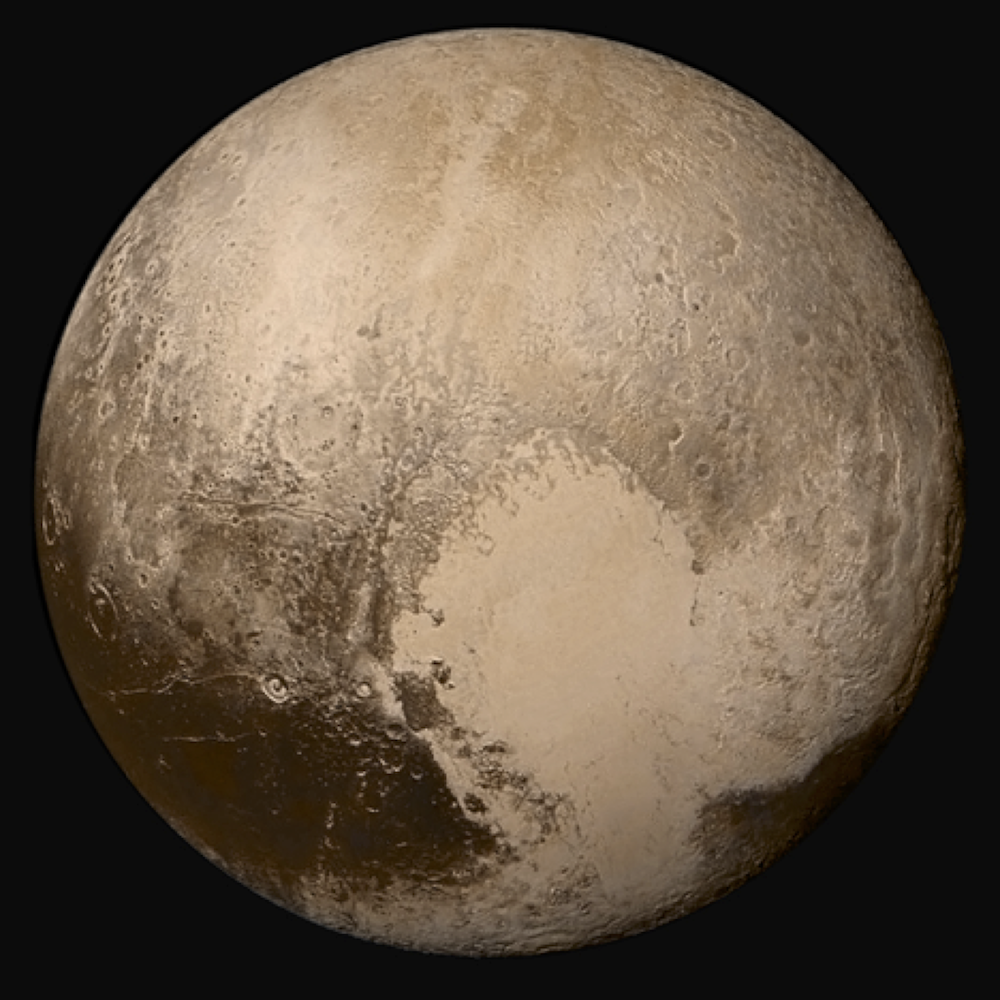
The last first exploration of the solar system: into the Kuiper Belt
Four images from New Horizon’s Long Range Reconnaissance Imager (LORRI) were combined with the Ralph instrument’s color data to form a photo of the planet’s entire circumference. (Image courtesy NASA/JHUAPL/SwRI)
How do you make the outer space equivalent of a golf putt from New York City to a soup can in Los Angeles? For Alan Stern, it takes 11 years of lobbying, four years of planning and building, nine-plus years in transit, and roughly $700 million.
It also took “a labor of love, and an incredible commitment to meet this goal,” said Stern, the principal investigator for NASA’s New Horizons mission.
New Horizons succeeded in its “golf putt” from Earth to a close flyby of the planet Pluto in late July. As the data from the spacecraft slowly reaches Earth over the next year (currently, only about 15 percent has been received), Stern and his colleagues can breathe a sigh of relief and begin planning the next move.
Stern spoke about the mission’s past and future at the Massachusetts Institute of Technology in Cambridge, Mass. during CASW’s New Horizons in Science briefings at the ScienceWriters 2015 conference.
The New Horizons mission “turned out fantastically and better than I expected, and I expected it to be spectacular. It was just über-spectacular,” Stern said.
An encounter more than two decades in the making
The mission’s outlook hasn’t always been so bright. During his talk, Stern reiterated the challenges he and his team faced in getting New Horizons off the ground.
“By the time we finally got the money out of the Washington Beltway, 14 years had elapsed,” Stern said.
He recalled how in 2001, after he won NASA’s competition to lead the Pluto mission, his fellow scientists would call Stern congratulating him—and then go on to say that there was no way his team had the time or money to make the mission a reality.
“So I pulled the team together and I said, ‘We’re going to have to rise to this challenge,’” Stern remembered. “And we did.”
Although part of Pluto’s popularity came from its status as the last ‘unexplored’ planet (or dwarf planet, as it were) in our solar system, the reason for the New Horizons mission was not simply unfinished business, Stern said.
“You don’t get to spend this kind of money and resources just to check a box,” Stern said.
Prior to New Horizons, the best picture of Pluto was a grid of grayscale squares. Without knowing what it represents, the photograph could be anything from a soccer ball to a person’s face. Stern and his team are using information from their flyby to provide a higher-resolution view of the planet.
The third kind of planet from the sun
The discovery of the Kuiper Belt, a region of rocks and icy objects extending beyond Neptune’s orbit to which Pluto belongs, may have relegated the former planet to one of three official “dwarf planets.” However, it also gave scientists such as Alan Stern additional impetus for a mission to Pluto—and beyond.
“In our solar system, we thought there were only two types of planets—the rocky terrestrials and the gas giants—and now we’ve discovered a third type,” Stern said. “And that’s a huge discovery, and it was completely unexpected.”
He is unfazed by Pluto’s demotion to dwarf planet.
“The solar system was very good at making planets, most of them small. We need to get over the fact that we can’t remember all their names,” Stern said.
The next stop for New Horizons, pending NASA funding, is a flyby of one of these Kuiper Belt objects. These objects, of which Pluto is the largest, are thought to be similar to the building blocks of the solar system. Studying them may shed light on the origins of planets.
Pluto used to be known as the “misfit” planet, but it seems to have found its place in the solar system.
“I think it really shows how people love exploration,” he said. “We were really lucky to be running this anchor leg—the last first exploration in our solar system.”